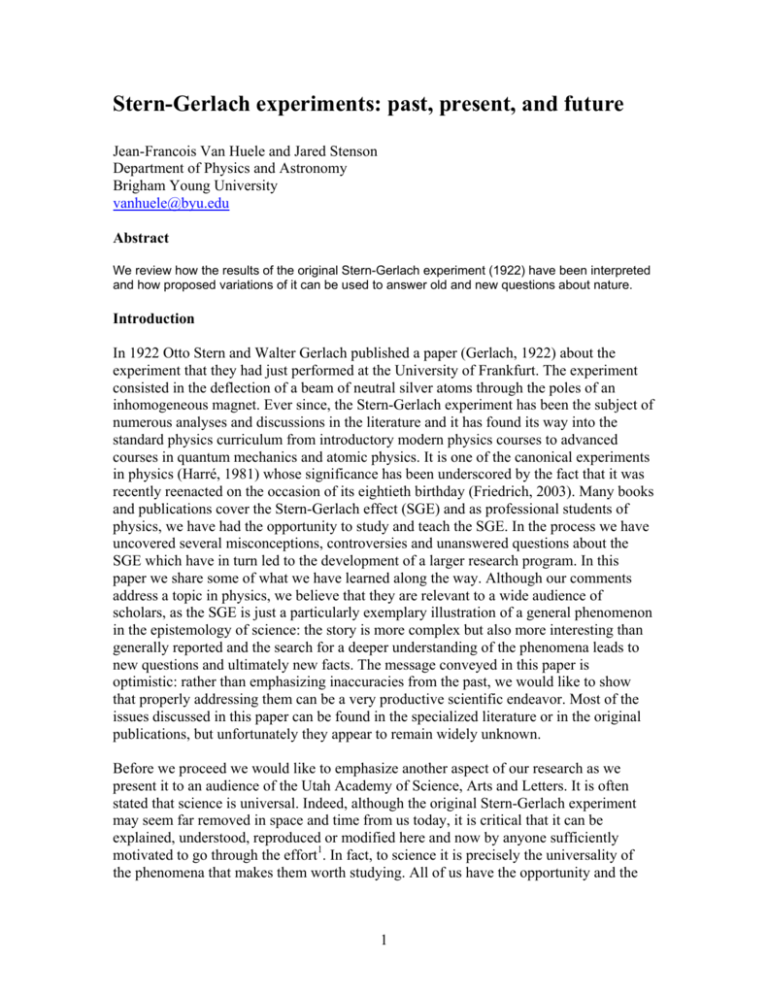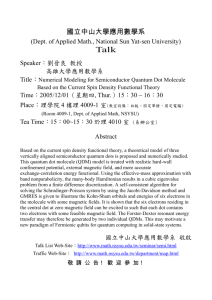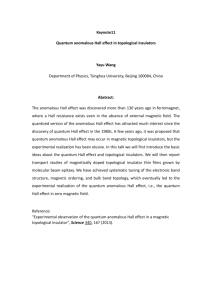Stern-Gerlach experiments: past, present, and future
advertisement

Stern-Gerlach experiments: past, present, and future Jean-Francois Van Huele and Jared Stenson Department of Physics and Astronomy Brigham Young University vanhuele@byu.edu Abstract We review how the results of the original Stern-Gerlach experiment (1922) have been interpreted and how proposed variations of it can be used to answer old and new questions about nature. Introduction In 1922 Otto Stern and Walter Gerlach published a paper (Gerlach, 1922) about the experiment that they had just performed at the University of Frankfurt. The experiment consisted in the deflection of a beam of neutral silver atoms through the poles of an inhomogeneous magnet. Ever since, the Stern-Gerlach experiment has been the subject of numerous analyses and discussions in the literature and it has found its way into the standard physics curriculum from introductory modern physics courses to advanced courses in quantum mechanics and atomic physics. It is one of the canonical experiments in physics (Harré, 1981) whose significance has been underscored by the fact that it was recently reenacted on the occasion of its eightieth birthday (Friedrich, 2003). Many books and publications cover the Stern-Gerlach effect (SGE) and as professional students of physics, we have had the opportunity to study and teach the SGE. In the process we have uncovered several misconceptions, controversies and unanswered questions about the SGE which have in turn led to the development of a larger research program. In this paper we share some of what we have learned along the way. Although our comments address a topic in physics, we believe that they are relevant to a wide audience of scholars, as the SGE is just a particularly exemplary illustration of a general phenomenon in the epistemology of science: the story is more complex but also more interesting than generally reported and the search for a deeper understanding of the phenomena leads to new questions and ultimately new facts. The message conveyed in this paper is optimistic: rather than emphasizing inaccuracies from the past, we would like to show that properly addressing them can be a very productive scientific endeavor. Most of the issues discussed in this paper can be found in the specialized literature or in the original publications, but unfortunately they appear to remain widely unknown. Before we proceed we would like to emphasize another aspect of our research as we present it to an audience of the Utah Academy of Science, Arts and Letters. It is often stated that science is universal. Indeed, although the original Stern-Gerlach experiment may seem far removed in space and time from us today, it is critical that it can be explained, understood, reproduced or modified here and now by anyone sufficiently motivated to go through the effort1. In fact, to science it is precisely the universality of the phenomena that makes them worth studying. All of us have the opportunity and the 1 obligation to rediscover the facts for our selves. It is therefore of some concern when misconceptions propagate through the literature. The paper is organized as follows: after telling the standard SGE story we review explicit misconceptions that go with it and which we classify in two categories: 1) a lack of historical accuracy leading to a misunderstanding of the motivation of the original work, and 2) a lack of mathematical rigor leading to hidden assumptions and approximations which prove to be very interesting by themselves as they allow us to ask what exactlty constitutes a valid explanation. We conclude with some considerations on the necessary balance between accuracy and simplicity2. The classical SGE story and how it is supposed to fail in order to exemplify quantization, spin, entanglement and measurement in quantum mechanics. The importance of the SGE follows from its close relation to some of the most fascinating concepts in modern physics: the idea of quantization, that of spin, and the controversial processes of entanglement and measurement in quantum mechanics. Indeed all these concepts can be introduced by observing what happens to a beam of particles endowed with a magnetic moment traveling between the poles of a magnet. Many quantum texts actually use the SGE in their introductory chapter to get to the heart of the matter with minimal mathematical formalism. In other books the topic fits naturally in the section on spin. To highlight the novelty of the discovery the inadequacy of the classical description is contrasted to the experimental results. Figure 1 illustrates3 the classical story and how it fails. The particles produced in an oven are collimated and sent (coming from left in the picture) between the poles of a magnet that creates an inhomogeneous magnetic field. The randomly oriented microscopic magnets constituted by the particles will feel the magnetic field and the resulting torque will tend to orient the magnets along the magnetic field just like a compass needle follows the orientation of Earth’s magnetic field. Fig.1.The beam in the magnetic field. The inhomogeneity of the field however will lead to a net force as the opposing forces of the field on each of the two poles will be proportional to the strength of the field at the location of the pole. The initial orientation of the particle’s magnetic moment will therefore completely4 determine the magnitude of the net force and the resulting acceleration will produce a deflection of the trajectory. S S N S N N S N The location of the impact of the 2 particles on a screen behind the magnet will therefore be indicative of the original orientation of the microscopic magnets. Randomly oriented magnets lead to a continuous distribution of impacts along the direction of the magnetic field. In contrast to this happy ending, the experimental reality replaces the continuous trace by two impacts, seemingly implying that only two original orientations were present instead of a random and continuous distribution of orientations. The concept of quantization comes about because the orientation of the magnetic moments along the magnetic field can only take on a discrete number of values – apparently two in this case. Since the magnetic moments of the particles are known to be parallel to their angular momentum, we speak of space quantization5. Because orbital angular momenta are known to take on only odd values in quantum mechanics, the splitting into the two beams, corresponding to the only two orientations of the magnetic moment reveals something different, namely an intrinsic duplicity (known as up/down) of the particles themselves, their spin property. The coupling of the trajectory and therefore the momentum of the particles with their a-priori independent orientation is an example of entanglement caused by the magnetic field and therefore the experimenter’s choice. Finally we can learn that we have not so much found a preexisting condition (whether each individual particle is up or down), as created it through the process of measurement for if we choose to orient the magnetic field in a different direction, say horizontal rather than vertical, we still observe the separation of the beam into two components along a horizontal up and horizontal down direction (more aptly called front and back). The beauty and complexity of quantum systems can be further developed by considering what happens when the beam is subjected to a succession of Stern-Gerlach measurements along orthogonal and non-orthogonal axes. Instead of following this path (Townsend, 1981) we will now review some misconceptions that result from the preceding story. Historical issues surrounding the presentation of the inadequacy of the classical SGE story Whereas space quantization was very much on Stern and Gerlach’s mind in 1922 when they performed the experiment, spin, entanglement, and measurement in quantum mechanics were not. Spin was not introduced until 1925 by Goudsmit and Uhlenbeck to explain the anomalous Zeeman effect. Indeed we are not aware of anyone making the connection between the SGE and spin until five years after the experiment (Phipps, 1927). Any statement about Stern’s surprise at finding an even number of lines (Tippler, 2002) makes for a dramatic pedagogical moment but is surely apocryphal. In his paper proposing the experiment, which was published in 1921 before the observation of any line separation, Stern does actually predict the observation of two lines (Stern, 1921). This information raises a new research question to the current student in quantum physics. How could Stern expect an even number of lines before the introduction of spin and half-integer quantum numbers? Quantum mechanics teaches us that the number of lines is odd for integer quantum numbers and even for half-integer quantum numbers. Before we address this issue let us remove another misconception by noticing that the Stern-Gerlach experiment also predates the invention of quantum mechanics by several years whether in Heisenberg’s matrix mechanical form of 1925, in Schrödinger’s wave 3 mechanical form of 1926 or in Dirac’s and Feynman’s later formulations. The very concept of entanglement (Schrödinger-1935) and the whole measurement issue gained prominence only much later (with the Einstein-Podolski-Rosen paper of 1935 and the Bohr-Einstein Solvay debates in1927). Einstein and Ehrenfest did however point out the unusual selection of the quantization axis by the direction of the magnetic field (Einstein, 1922). The proper theory in 1922 to discuss the SGE was Sommerfeld’s 1916 expanded version of Bohr’s old quantum theory (Sommerfeld, 1916), consisting of quantization rules superposed on a classical ontology such as particle trajectories and electron orbits. This theory involves integer quantum numbers but an even number of angular momentum orientations, two for the ground state which applies to the particles of the SGE. Although now superseded by quantum mechanics, this theory gave the correct number of lines for the SGE, albeit for what we would now call the wrong reasons. Far from “discovering” spin6, the SGE seemed to confirm the existing paradigm7.The modern treatment of the SGE in terms of spin can also lead to the obfuscation of a very different issue, that of the nature of the particles in the beam. In the historical experiment performed by Stern and Gerlach, the beam consisted of neutral silver atoms, the magnetic moment of the atoms being identified with the magnetic moment of the single unpaired 47th atomic electron. In the story above, the exact nature of the particle carrying the magnetic moment does not matter since the only relevant variables are the value and orientation of this magnetic moment. What matters is the fact that the beam consists of spin-1/2 particles with only two possible orientations along any axis for the magnetic moments. One should note, however, that identifying the beam as spin-1/2 particles rather than as silver atoms does lead to more than a historical omission. It bypasses the issue of discussing to what extent an atomic electron and its magnetic moment are equivalent to a free electron and its magnetic moment, and it may lead to the impression that the SGE can be and/or has been performed with a beam of electrons. It turns out that neither of the preceding statements is correct. It also turns out that this very issue was the subject of a very lively debate8. Bohr argued that, as a matter of principle, and in contrast to what happens in the atomic SGE, the magnetic moment of a free electron cannot be measured in an experiment involving classical concepts like particle trajectories. Spin is a non-classical duplicity useful for classifying atomic states but not observable with free electrons. The concrete argument against the observation of the electron SGE was provided by Pauli (Pauli, 1932) who showed that the interaction of the charge with the magnetic field causes an incompressible blurring of the trajectories at least as large as the separation between the spin components. Brillouin (Brillouin, 1928) proposed an ingenious set-up for measuring a longitudinal SGE (with the magnetic field along the beam axis). Much later Dehmelt (Dehmelt, 1986) claimed to have proven Bohr wrong by measuring the continuous SGE in a Penning trap. Encouraged by Dehmelt’s claims, several analyses (Batelaan 1997; Rutherford 1998; James, 2003) have been made to evaluate the feasibility of observing the transverse and longitudinal electron SGE and one can hope that an old question may get a new answer soon. Before all these questions can satisfactorily be solved some other misconceptions of a more technical nature need to be resolved. In the next section we take exception to the mathematical treatment and logical structure of the inadequate classical story and its quantum replacement. 4 Mathematical issues surrounding the SGE story and its quantum solution The mathematical issues are related to the correct treatment of the magnetic field. We have so far assumed that the magnetic field was acting along one preferred axis only, which we took to be vertical (in fig.1) or possibly horizontal in a different Stern-Gerlach experiment or in successive Stern-Gerlach experiments. The only acceptable unidirectional magnetic field is a homogeneous one. This field will not do to obtain the SGE. As explained above, it is the field inhomogeneity (its variation in space) that causes the force differential and acceleration needed for the beam separation (whether continuous or quantized). Maxwell’s equations prevent magnetic fields from having a single (say, vertical) inhomogeneity as can also be seen in fig.1. A violation of this law has very serious consequences as it expresses the impossibility of having isolated magnetic poles (a north pole without a south pole). Pauli actually used this very fact to argue against the electron SGE. Still, this fact is omitted in most treatments of the SGE, thereby silently violating Maxwell’s equation. When the existence of a second (say, horizontal) inhomogeneity is acknowledged, it is immediately neglected as unimportant. Not because it is small (Maxwell again doesn’t allow the horizontal inhomogeneity to be any smaller than the vertical inhomogeneity) but because its effect is averaged to zero over time. Before we proceed, we want to point out a fundamental shortcoming of the general approach to the explanation of the SGE. Going back to the classical story and neglecting the issues of violating Maxwell’s equation for right now, it should be clear that, whereas the demonstration of the failure of the classical picture to predict a continuous deviation of the trajectories is convincing, arbitrarily dropping all trajectories except the two corresponding to the observed lines on the screen is hardly satisfactory. In the spirit of Bohr’s old quantum theory it consists in adding quantum constraints to a classical description that we otherwise reject. Whereas in the Bohr model of the hydrogen atom a single constraint can be chosen to match the infinite lines of the emission and absorption spectra, in this case, the constraint is nothing more than just keeping what we want and rejecting what we do not want! It should be clear now that what is needed here is an understanding of the SGE using quantum theory, not just a statement that the classical explanation is inadequate. The same flaw appears in the justification of the neglect of the horizontal field inhomogeneity. Authors9 who actually do so, invoke the (classical) precession of the magnetic moment around a dominant homogeneous field in the vertical direction. Quantum mechanically one can at best hope that the expectation value of the magnetic moment averages to zero. However a calculation of the expectation values involves the full quantum mechanical solution of the Stern-Gerlach field configuration which leads to a circular argument. 5 In the process of unraveling the subtleties of the magnetic field configuration, we have just discovered another important fact that is not generally recognized: whereas it is the inhomogeneous part of the magnetic field that leads classically to the deflection of the beam, it is the homogeneous part that (classically) suppresses this very deflection to occur in any direction but that of the chosen axis, the vertical in fig.1. It is the homogeneous field that triggers the measurement. The relative strength of homogeneous and inhomogeneous fields should therefore be an important parameter for the observability of the SGE. As an illustration of the productive nature of this line of questioning, we would like to propose an experiment in a purely inhomogeneous field. Such fields that do not violate Maxwell’s equations can be constructed. It would seem that no suppression of deflections should be taking place, leading to deflections in all directions, which, when properly quantized, should give a simultaneous measurement of the vertical and horizontal components of the magnetic moment, an absolutely forbidden occurrence according to quantum mechanics. Whether the cross-sectional shape of the beam (another important experimental and theoretical issue which we have neglected in this discussion) or the longitudinal variation of the field (after all, the beam needs to enter and to exit the magnets at some stage) provide the necessary symmetry breaking to select a measurement is currently an open problem. It will have to be addressed eventually. Outlook and Conclusions We are currently examining some of the issues mentioned above. We are fortunate to have many competing formulations of quantum theory to provide us with calculational schemes and pictures of what exactly happens to a beam of spin-1/2 particles in a SternGerlach experiment. To mention a few, we can solve quantum wave equations and construct packets of solutions to follow the particles they represent. We can use semiclassical methods to monitor expectation values and deviations for trajectories. We can examine Bohmian trajectories or probability flows in hydrodynamical models of quantum theory. In each of these formulations we can choose to include relativity and decide how to include spin. In all cases we want to recover the result of Stern-Gerlach experiments that have been performed and make informed predictions for experiments that are yet to be tried. We conclude that after more than eightty years in the limelight, the SGE is still a major source of inspiration. Although the historical experiment is unique, the limitations built in its theoretical description have generated new questions and proposals for new experiments. We have illustrated how tackling often neglected issues in the description of the SGE has led us to new questions. It is clear that science must use modeling, simplifications and approximations, in order to extract manageable mathematical results as well as useful concepts and pictures. It is clear that simplification is also a pedagogical tool as it allows us to concentrate our attention on the most critical aspects of a complex problem10. Approximations and shortcuts have their place in science and we should use them. It is important however that when we do, it is the result of a deliberate choice, rather than the display of our ignorance. 6 Notes 1 It should be mentioned that a research program was undertaken by John Gardner and collaborators at Brigham Young University in the nineteen fifties to make a direct measurement of the gyromagnetic ratio of the free electron in a rather direct extension of the technique of Stern and Gerlach (Knight, 1959; Jones, 1959). 2 This reminds one of the Bohr-like complementarity principle between clarity and rightness of a statement. 3 In this schematic illustration the curved arrows represent the deflected trajectories. 4 We assume here that the beam is infinitely thin so that the location of the magnetic moment does not matter. 5 Space quantization refers here to a quantization in space rather than a quantization of space itself as is now considered in theories of quantum gravity. 6 observation of a manifestation of spin (unknowingly) does not qualify as discovery. 7 Parenthetically, this spinless and relativistic theory also gives a more accurate spectrum for hydrogen than both the nonrelativistic and relativistic spinless versions of the quantum mechanical theory that would replace it and did just as well as Dirac’s later relativistic theory with spin of 1928! The picture that emerges from this somewhat cursory discussion of the development of successive quantum theories is very different from that of a linear progression and gradual improvement. Obviously this begs the question as to what other reasons motivated the acceptance of the theories as they developed. 8 This debate has in common with the more famous Einstein-Bohr debates on the completeness of quantum mechanics that it took place at a Solvay Council in Brussels, that Bohr was one of the protagonists and that he apparently prevailed. However, unlike the Bohr-Einstein debate, it has been mostly ignored by scholars of the foundations of quantum theory and has only been rediscovered more recently (Garraway, 2002). 9 See,e.g., (Griffiths,1995). 10 An analysis of the SGE as a possible Kuhnian episode of revolutionary science made to look linear when reported in textbooks would certainly be of considerable interest. Works Cited 7 Batelaan, H., Gay, T.J., and Schwendiman, J.J. (1997), ``Stern-Gerlach effect for electron beams," Phys.Rev.Lett. 79, 4517-4521. Brillouin, Leon, (1928), ``Is it possible to test by a direct experiment the hypothesis of the spinning electron? ," Proc.Natl.Acad.Sc.USA 14, 755-763. Dehmelt, Hans (1986), ''Continuous Stern-Gerlach effect: principle and idealized apparatus," Proceed.Natl.Acad.Sc.USA, 83, 2291-2294. Einstein, Albert and Ehrenfest, Paul (1922), ``Quantentheoretische Bemerkungen zum Experiment von Stern und Gerlach," Z. Phys. 11, 31-34. Friedrich, Bretislav and Herschbach, Dudley (2003), ``Stern and Gerlach: How a bad cigar helped reorient atomic physics", Phys.Today, Dec. 2003, 53. Garraway, B.M. and Stenholm, S. (2002), ''Does a flying electron spin?'', Cont.Phys. 43, 147-160. Gerlach, W. and Stern, Otto, (1922), ''Der experimentelle Nachweiss der Richtungsquantelung im Magnetfeld," Zeits.Phys. 9, 349-355. Griffiths, David J., (1995), “Introduction to Quantum Mechanics” (Prentice Hall, Englewood Cliffs). Harré, Rom, (1981), ``Great Scientific Experiments: 20 experiments that changed our view of the world, (Phaidon, Oxford). James, Daniel and Van Huele, Jean-Francois, (2003),``Semi-classical study of electron blurring in the magnetic field of a current ring’’, Bull. Am. Phys. Soc., 48, 10, 24. Jones, Douglas E., (1959), ``A measurement of the magnetic moment of Lithium7 in Bohr magnetons at 24,000 megacycles using narrow band detection," M.S. Thesis, Brigham Young University. Knight, Larry V., (1959), ``Magnetic dipole detection of the cyclotron resonance of the free electron," M.S. Thesis, Brigham Young University. Pauli, Wolfgang,(1932), ``Les théories quantiques du magnétisme. L'électron magnétique," in 6ième Conseil de Physique Solvay, Le Magnétisme, Bruxelles,1932, pp.175-280, (Paris). Phipps, T.E. and Taylor, J.B., (1927), ``The magnetic moment of the hydrogen atom," Phys.Rev. 29, 309-320. Rutherford, G.H., and Grobe, R (1998), ``Spin dynamics of electrons in a unidirectional, inhomogeneous, magnetic field, "J.Phys.A 31, 9331-9340. Sommerfeld, Arnold, (1916), ``Zur Quantentheorie der Spektrallinien", Annalen der Physik 51, 17, 1-94 & 125-167. Stern, Otto, (1921), ''Ein Weg zur experiemtellen prufung der Richtungsquantelung im Magnetfeld" Zeits.Phys. 7, 249-253. Tipler, Paul A. and Ralph A. Llewellyn, (2002), Modern physics (W.H. Freeman and Company). Townsend, John S. (1992) A Modern approach to quantum mechanics, (Mc Graw-Hill, NewYork). 8









